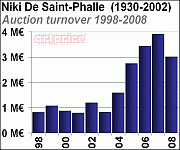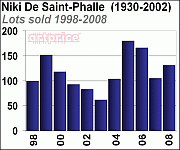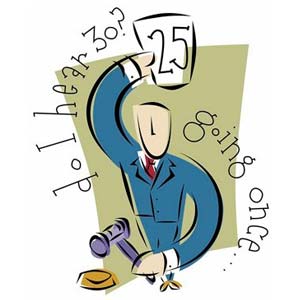Dissecting Christie’s Feb 09 Art Auction Pt. 1 – artmarketblog.com
 I am going to make a slight diversion from my previous post on evaluating art auction results (which will be continued very soon) because I want to take a bit more of an in depth look into the actual works that were included in the recent February round of Impressionist and Modern Art auctions to see what the sales can tell us about the art market and about the success of each sale. By looking at the sale history of each work, especially the very last time the work was sold, one can get a good idea about how the art market is tracking. I also believe that the statistics relating to whether the price paid for a work of art has increased or decreased since it was last sold should be used as an indication as to whether or not the sale was a success or not in the context of the current art market conditions but not as the sole indicator of whether or not the sale was a success in the context of the performance of the auction house.
I am going to make a slight diversion from my previous post on evaluating art auction results (which will be continued very soon) because I want to take a bit more of an in depth look into the actual works that were included in the recent February round of Impressionist and Modern Art auctions to see what the sales can tell us about the art market and about the success of each sale. By looking at the sale history of each work, especially the very last time the work was sold, one can get a good idea about how the art market is tracking. I also believe that the statistics relating to whether the price paid for a work of art has increased or decreased since it was last sold should be used as an indication as to whether or not the sale was a success or not in the context of the current art market conditions but not as the sole indicator of whether or not the sale was a success in the context of the performance of the auction house.
The financial crisis is the primary cause of the decrease in prices although the prices being paid for art would not have had as far to fall had the auction houses not encouraged the continual inflation of prices. Because the auction houses are not directly responsible for the drop in prices and are not really able to do much to increase prices, the difference in price paid for works of art at current sales compared with past sales are not, on their own, a very good indicator of the success of the sale from the auction house’s point of view. Auction houses have to sell works of art regardless of whether or not they are going to achieve a higher price than the last time the work was sold at auction. If a vendor comes to them with a work to sell that is going to sell for a large amount of money but not as much as it sold for last time it was sold at auction it is most likely that the auction house will sell the work. Whether or not the price paid for a work at a current auction is higher or lower than when it was last sold is not that much of a concern for the auction houses because their focus is getting as much for a work of art as they can in the current market and not providing a return on investment for the vendor. Of course, the vendor will be much happier with the auction house if they do receive a decent return on their investment. What the difference in price data is good for is providing a very good indication of the success of the sale in terms of the current art market conditions and also providing an indicator of the current state of the art market. This data also provides valuable information relating to the type of works that are most likely to remain stable or increase during a financial crisis/art market correction.
The data that I have provided below is from the Christie’s Impressionist and Modern Art sale that took place on the 4th of Febuary 2009. What I did was look at the auction sale history of every work that sold and recorded if the work had been previously sold at auction or not, and if so, what price was paid. Because there is a significant amount of data to present I will post the data in two separate posts and then provide an analysis of the data in a third post. The first ten works listed are those that Christie’s highlighted as the ten highest prices paid for works at the auction and the rest are in lot order. An analysis of the Sotheby’s Feburary Impressionist and Modern Art sale will be conducted for comparison at a later date.
Sold lots from Christie’s February 4 2009 Impressionist and Modern Art auction:
–Henri de Toulouse-Lautrec (1864-1901), L’abandon (Les deux amies), 1895: This work sold for $8,917,398 (including buyers premium) against an estimate of $7,125,000 – $9,975,000 and was referred to by Christie’s as being one of the highlights of the sale. Prior to being in sold at the Feb 4 2009 Christie’s sale, the same work was sold by Sotheby’s in May of 2000 for $9,355,750 which means the price for this work dropped more than $400,000.
-Claude Monet (1840-1926), Dans la prairie, 1876: The top price of the Christie’s sale was achieved by Monet’s “Dans la prairie” which sold for $16,164,918. Last time this work was sold in 1999 by Sotheby’s it achieved $15,402,500 which means that the price for this work increased by $764,000.
-Amedeo Modigliani (1884-1920), Les deux filles, 1918: Offered at auction for first time after being in the same family since being purchased from the artist. Sold for £6,537,250 against an estimate of £3,500,000 – £5,500,000
-Edouard Vuillard (1868-1940), Les couturiers, 1890: Sold for £6,537,250 against an estimate of £3.5-£5.5 million. No previous auction sale history
-Kees van Dongen (1877-1968), La cuirasse d’or, circa 1907: Sold for £2,617,250 against an estimate of £1.5 million-£2.5 million. No previous auction sale history
-Henry Moore (1898-1986), Reclining Mother and Child,conceived in 1960: Sold for £2,617,250 (US$3,763,606) against an estimate of £1,500,000 – £2,000,00 . Previously sold by Christie’s in November 2002 for US$1,439,500 against an estimate of US$1,000,000 – $1,500,000 which represents an increase in price of US$2,300,00.
-Fernand Léger (1881-1955), Les deux soeurs, 1929: Sold for £1,900,000 (hammer price) against an estimate of £2,000,000 – £3,000,00. Previously sold by Loudmer (Paris) in 1990 for £1,231,263 (hammer price) which represents an increase in price of £669,000
-Paul Gauguin (1848-1903), Les dindons, Pont-Aven,1888: Sold for £2,057,250 (US$2,958,326) against an estimate of £2–3 million. Previously sold by Christie’s New York in 1998 for $2,862,500 which represents an increase in price of US$95,000
-Alexej von Jawlensky (1864-1941), Mädchen mit roter Schleife, 1911: Sold for £1,945,250 against an estimate of £1,800,000 – £2,500,000. Previously sold by Christie’s in February 2008 for £2,932,500 which represents a decrease in price of £990,000 pounds
-Alexej von Jawlensky (1864-1941), Tanz mit gelbem Fächer, 1912: Sold for £1,833,250 against an estimate of £1,500,000 – £2,500,00. No previous auction sale history
-Henri Laurens (1885-1954), La femme à la guitar, 1919: Sold for £713,250 against an estimate of £350,000 – £400,000. No previous auction sale history
-Egon Schiele (1890-1918), Stehende Frau mit Schuen und Strümpfen, 1913: Sold for £601,250 against an estimate of £550,000 – £750,000. No previous auction sale history
-Wassily Kandinsky (1866-1944), Aquarell für Poul Bjerr, 1916: Sold for £433,250 against an estimate of £300,000 – £500,00. Previously sold by Christie’s in February 2008 for £670,100 which represents a decrease in price of £236,000 pounds
-Kees van Dongen (1877-1968), Femme aux deux colliers: Sold for £1,329,250 against an estimate of £300,000 – £600,00. No previous auction sale history
-Kees van Dongen (1877-1968), La gitane: Sold for £1,105,250 against an estimate of £500,000 – £1,000,000. No previous auction sale history
-Kees van Dongen (1877-1968), La femme au collant vert, 1905: Sold for £1,105,250 against an estimate of £800,000 – £1,200,00. Previously sold by Paris auctioneer Palais Galliéra in 1962, price unknown.
-Henry Moore (1898-1986), Family Group, 1945: Sold for £481,250 (US$692,038 ) against an estimate of £400,000 – £600,000 (US$570,000 – $855,000). Previously sold by Christie’s New York on the 7th of May 2003 for US$400,250 against an estimate of USD 250,000 – 350,000 which represents an increase in price of US$291,000
-Alberto Giacometti (1901-1966), Annette d’après nature: Sold for £937,250 against an estimate of £800,000 – £1,200,000. No previous auction sale history
-Alfred Sisley (1839-1899), La route de Marly-le-Roi, 1875: Sold for £825,250 against an estimate of £800,000 – £1,200,000. Previously sold by Christie’s in 2004 for £1463500 against an estimate of 1,000,000 – 1,500,000 and was offered for sale again at Christie’s in 2007 with an estimate of £1,600,000 – 2,400,000 but failed to sell. Using the 2004 sale statistics the price for this work dropped £600,000.
-Pierre Bonnard (1867-1947), Bord de mer, sous les pins, 1924: Sold for £1,273,250 against an estimate of £1,200,000 – £1,600,000. Previously offered for sale at Christies in February 2005 with an estimate of £2,000,000 – 3,000,000 but failed to sell.
-Alfred Sisley (1839-1899), Vue de Moret, 1889: Sold for £385,250 against an estimate of £250,000 – £350,000. Previously sold by Christie’s in February 2008 for £446,100 against an estimate of £400,000 – 600,000 which represents a decrease in price of £60,000.
-Paul Gauguin (1848-1903), Clovis: Sold for £735,650 against an estimate of £550,000 – £850,000. No previous auction sale history
-Emil Nolde (1867-1956), Violette Blumen, 1907: Sold for £881,250 against an estimate of £600,000 – £900,000. No previous auction sale history
-Emil Nolde (1867-1956), Blaue Stiefmütterchen, 1908: Sold for £361,250 against an estimate of £250,000 – £350,000. No previous auction sale history
-Ernst Ludwig Kirchner (1880-1938), Drei Pferde (recto); Landschaft (verso), c.1923: Sold for £959,650 against an estimate of £300,000 – £500,000. No previous auction sale history
-Ernst Ludwig Kirchner (1880-1938), Steinbruch bei Wildboden, c.1923: Sold for £457,250 (US$657,526) against an estimate of £400,000 – £600,000 (US$570,000 – $855,000). Previously sold by Christie’s New York in 1991 for US$320,625 which represents an increase in price of $337,000
 **Nicholas Forrest is an art market analyst, art critic and journalist based in Sydney, Australia. He is the founder of http://www.artmarketblog.com
**Nicholas Forrest is an art market analyst, art critic and journalist based in Sydney, Australia. He is the founder of http://www.artmarketblog.com , writes the art column for the magazine Antiques and Collectibles for Pleasure and Profit and contributes to many other publications.
, writes the art column for the magazine Antiques and Collectibles for Pleasure and Profit and contributes to many other publications.
Filed under: art, art auction, art investment, art market, art news, art sale, christie's | Tagged: art, art auction, art investment, art market, art news, art review, christie's | 5 Comments »
 **Nicholas Forrest is an art market analyst, art critic and journalist based in Sydney, Australia. He is the founder of http://www.artmarketblog.com
**Nicholas Forrest is an art market analyst, art critic and journalist based in Sydney, Australia. He is the founder of http://www.artmarketblog.com , writes the art column for the magazine Antiques and Collectibles for Pleasure and Profit and contributes to many other publications.
, writes the art column for the magazine Antiques and Collectibles for Pleasure and Profit and contributes to many other publications.



















 In Evaluating Art Auction Results Pt. 1 (see
In Evaluating Art Auction Results Pt. 1 (see  I am going to make a slight diversion from my previous post on evaluating art auction results (which will be continued very soon) because I want to take a bit more of an in depth look into the actual works that were included in the recent February round of Impressionist and Modern Art auctions to see what the sales can tell us about the art market and about the success of each sale. By looking at the sale history of each work, especially the very last time the work was sold, one can get a good idea about how the art market is tracking. I also believe that the statistics relating to whether the price paid for a work of art has increased or decreased since it was last sold should be used as an indication as to whether or not the sale was a success or not in the context of the current art market conditions but not as the sole indicator of whether or not the sale was a success in the context of the performance of the auction house.
I am going to make a slight diversion from my previous post on evaluating art auction results (which will be continued very soon) because I want to take a bit more of an in depth look into the actual works that were included in the recent February round of Impressionist and Modern Art auctions to see what the sales can tell us about the art market and about the success of each sale. By looking at the sale history of each work, especially the very last time the work was sold, one can get a good idea about how the art market is tracking. I also believe that the statistics relating to whether the price paid for a work of art has increased or decreased since it was last sold should be used as an indication as to whether or not the sale was a success or not in the context of the current art market conditions but not as the sole indicator of whether or not the sale was a success in the context of the performance of the auction house.
 The first round of major art auctions for 09 have proven that there is still a considerable amount of money available to be spent on top quality and rare works of art provided the price is right. Fresh works from private collections appeared to be particularly sought after, a sign that solid and extensive provenance continues to be a big draw card. Even some of the less impressive works were eagerly fought over which suggests that the low prices and the excitement of the year’s first major auctions may have induced a bit of over-enthusiasm. The conservative estimates gave buyers plenty of reason to open their wallets and the smaller sales encouraged healthy competition for the top works.
The first round of major art auctions for 09 have proven that there is still a considerable amount of money available to be spent on top quality and rare works of art provided the price is right. Fresh works from private collections appeared to be particularly sought after, a sign that solid and extensive provenance continues to be a big draw card. Even some of the less impressive works were eagerly fought over which suggests that the low prices and the excitement of the year’s first major auctions may have induced a bit of over-enthusiasm. The conservative estimates gave buyers plenty of reason to open their wallets and the smaller sales encouraged healthy competition for the top works. After all the predictions of doom and gloom that were made in relation to future of the art market during 2008 you may have begun to wonder why the correction that is taking place isn’t as bad as many people predicted. The reason that so many people predicted a major collapse of the art market is because the last time the art market took a dive in the early nineties, the dive was quite severe. What people need to realise is that the current art market is significantly different to what it was in the nineties and the circumstances under which the current correction is taking place are also considerably different.
After all the predictions of doom and gloom that were made in relation to future of the art market during 2008 you may have begun to wonder why the correction that is taking place isn’t as bad as many people predicted. The reason that so many people predicted a major collapse of the art market is because the last time the art market took a dive in the early nineties, the dive was quite severe. What people need to realise is that the current art market is significantly different to what it was in the nineties and the circumstances under which the current correction is taking place are also considerably different.


















